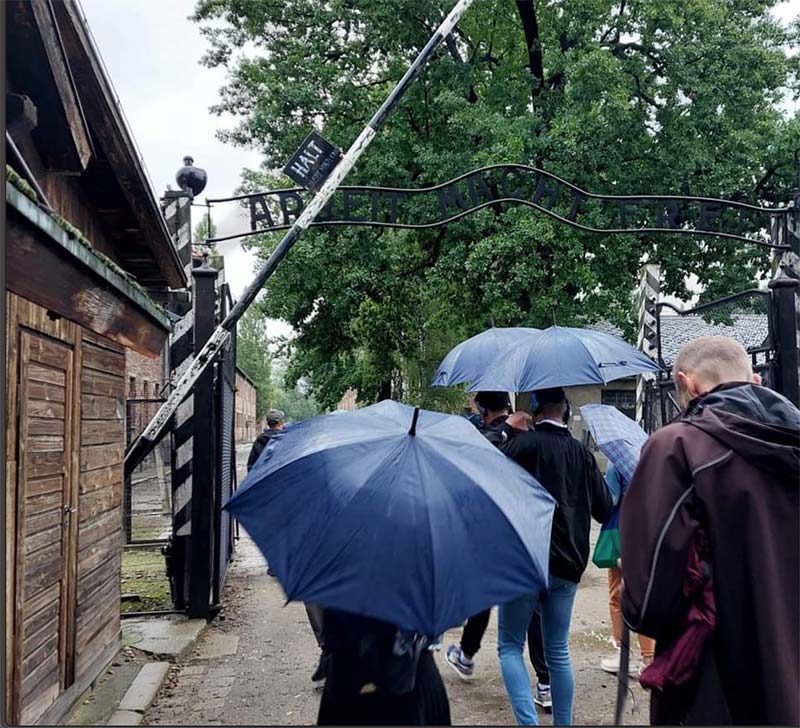“Look and Don’t Forget” Remembrance Initiative Commemorates Roma Genocide Memorial Day at Auschwitz-Birkenau

August 2 was Roma Holocaust Memorial Day, the anniversary of the day in 1944 that nearly 3,000 Roma and Sinti women, men and children in Auschwitz-Birkenau’s Zigeunerlager (then known as the “Gypsy family camp”) were killed in the concentration camp’s gas chambers.
Since 2010, the Dikh He Na Bister (“Look and Don’t Forget”, in Romani) Remembrance Initiative has been bringing international groups of young Roma and non-Roma to Auschwitz-Birkenau each Roma Holocaust Memorial Day, “also known as porajmos or samudaripen in Romani language, as part of a week-long series of workshops, lectures and meetings with survivors that takes place in nearby Krakow.
This year, Anabel Carballo-Mesa, a Spanish PhD student who in January visited USC Shoah Foundation to explore the 406 Roma and Sinti testimonies in the Visual History Archive, participated in the Dikh He Na Bister commemorations in Poland.
Along with Emram Elmazi—director of the Documentation and Cultural Centre for German Sinti and Roma and co-founder of TernYpe and the Dikh He Na Bister Remembrance Initiative—she spoke with USC Shoah Foundation about the meaning of August 2 and the long struggle for official recognition of the Roma and Sinti Genocide.
What does August 2 mean to the Roma and Sinti community?
August 2 is a symbolic day, a chance to raise awareness about the Roma and Sinti genocide, to learn about the Holocaust, and to explore ways to counter contemporary antigypsyism. As with January 27 (International Holocaust Remembrance Day), it’s an opportunity to remember and honor victims of the Holocaust.
But, of course, the Roma and Sinti community in Europe is very diverse, so the day has different meanings and values depending on the respective experiences of each Roma and Sinti community during WWII. The Zigeunerlager at Auschwitz-Birkenau contained Roma and Sinti from many nationalities, but the majority of people killed there were German Sinti and Roma. Other Roma and Sinti communities in Europe had different experiences—for instance at internment camps in France and Italy—so they may commemorate dates other than August 2 that are more resonant to them.
It was a long struggle to get August 2 officially recognized as Roma Holocaust Memorial Day. Has it also been difficult to get people to recognize and commemorate the day since then?
Roma and Sinti communities have been commemorating August 2 and travelling to Auschwitz-Birkenau to mark the liquidation of the Zigeunerlager since the early 1980’s.
On April 15, 2015, the European Parliament voted by an overwhelming majority to finally adopt a resolution that recognizes the genocide against the Roma and Sinti and decreed August 2 to be Roma Holocaust Memorial Day.
It was a long fight to gain this recognition at the international level, and, in some countries, it’s still a struggle to get governments to recognize and observe the day at the national level.
But ultimately, the struggle is not as much about getting people to commemorate August 2. It’s about the fact that so much remains to be done around Europe with regards to recognition, remembrance, research and education of the Genocide of Roma and Sinti—especially when it comes to preserving memorial sites.
Tell us about the Dikh He Na Bister remembrance events at Auschwitz-Birkenau.
The Dikh He Na Bister initiative aims to raise awareness among young Europeans, civil society and decision makers about the Roma and Sinti Genocide and the prevalence of antigypsyism in the context of rising racism, hate speech, war and extremism in Europe.
This year—the 78th anniversary of August 2—close to 200 young people from more than 15 countries took part in commemoration events at Auschwitz-Birkenau and in workshops and lectures in Krakow. Prior to the official commemoration ceremony at Auschwitz-Birkenau on August 2, Dikh He Na Bister youth groups held an event in front of Crematorium V—the gas chamber in which the Roma and Sinti were killed—which was a very emotional moment of the visit.
There were also August 2 commemorations in many other European countries, the majority of which were promoted and led by Roma and Sinti organizations and which, in many cases, were attended by official government representatives.
As with Jewish survivors of the Holocaust, the numbers of Roma and Sinti survivors of the Holocaust are dwindling. What is being done to capture the testimonies of any Roma and Sinti survivors who would like to speak about their experiences?
The Documentation and Cultural Centre for German Sinti and Roma in Heidelberg, Germany has been collecting testimonies since the 1980s and now has almost 200 of them. It is planned that these will feature on a new online educational platform in the future. The main goal of the platform will be to share educational materials based on collected testimonies and ensure that people don’t forget what happened.
-- --
To learn more about the Roma and Sinti community visit https://sfi.usc.edu/education/roma-sinti/en/. Resources in English and Italian were developed by USC Shoah Foundation in partnership with the Universita Cattolica del Sacro Cuore with support from the International Holocaust Remembrance Alliance.
Like this article? Get our e-newsletter.
Be the first to learn about new articles and personal stories like the one you've just read.